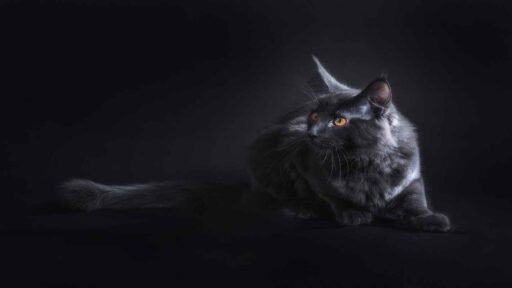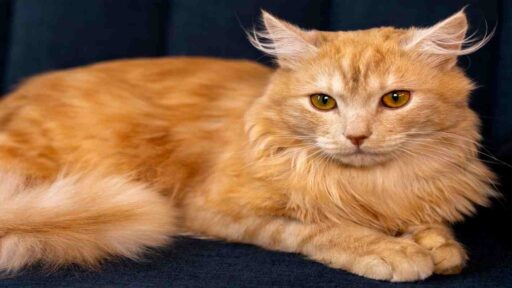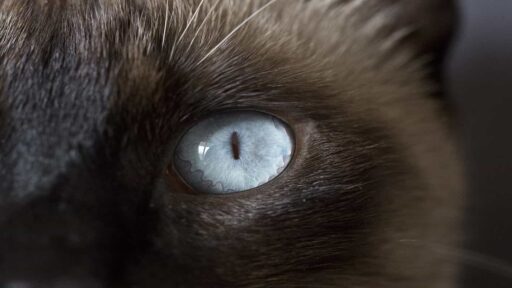The captivating Blue Persian Cat, known for its enchanting blue coat ranging from a soft grayish-blue to a deep and rich slate hue, embodies elegance with its distinctive flat face, large expressive eyes, and luxurious long fur. These cats are renowned for their calm and affectionate demeanor, making them delightful companions. Maintaining their exquisite coat requires regular grooming, and their laid-back nature further enhances the charm of these beloved feline friends.
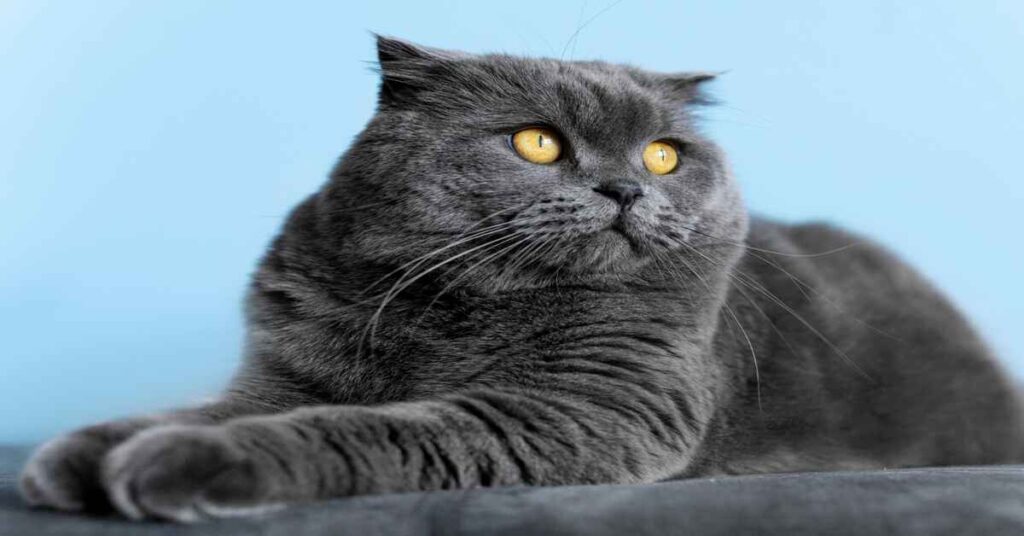
Blue Persian Cat Characteristics
Physical characteristics
The Blue Persian Cat exhibits a striking appearance and unique features. One of its most prominent traits is its luxurious long fur, which presents in various shades of blue, spanning from a light, almost silvery hue to a deep, slate blue. Regular grooming is necessary to prevent matting due to the dense and silky nature of their coat.
Recognizable for their distinctive flat-faced or brachycephalic head structure, these cats feature a short nose and large, expressive eyes that can be copper, blue, or even odd-eyed. Their small and rounded ears contribute to their adorable and doll-like appearance.
With a medium to large body, a robust build, and a short, bushy tail, the Blue Persian Cat displays an overall charming and graceful demeanor. The round and compact paws add to their appeal. Despite their regal appearance, Blue Persians are known for their calm and gentle nature, endearing them to those who appreciate both their beauty and laid-back personality.
Mental characteristics
Not only do certain physical traits distinguish the Blue Persian Cat, but it also possesses specific mental characteristics. Known for their calm and placid temperament, these felines are well-suited for indoor living, often forming strong bonds with their human companions.
Enjoying a laid-back disposition, Blue Persians create a serene atmosphere at home by lounging around. Although they may exhibit moments of playfulness, they are generally not as active as some other breeds, making them ideal for households seeking a more relaxed and undemanding pet.
Thriving in routine and stability, these cats appreciate environments where they feel secure. Despite their occasionally reserved demeanor, Blue Persians can be sociable, finding enjoyment in the company of their family members. Regular interactions and affectionate gestures reciprocate with the cat’s loyalty and companionship.
Blue Persian Cat origins
Like other Persian cats, the Blue Persian Cat has a rich and ancient history. The Persian cat breed originated in Persia (modern-day Iran), with roots tracing back to the 1600s or possibly even earlier. During the 17th century, the breed gained popularity in Europe, renowned for its luxurious coat and distinctive appearance.
The development of the Blue Persian color variation results from a dilution gene affecting the coat color. The breed standard recognizes various colors, with blue encompassing a range from light to dark shades. Over the years, the breeding and selection process has refined the characteristics of Blue Persians, highlighting their unique and captivating coat color.
The general introduction of Persian cats to the United States occurred in the late 19th century, swiftly earning popularity for their elegance and gentle temperament. The breed, including various color variations such as the Blue Persian, continues to be adored by cat enthusiasts worldwide, showcasing its enduring appeal and evolving legacy.
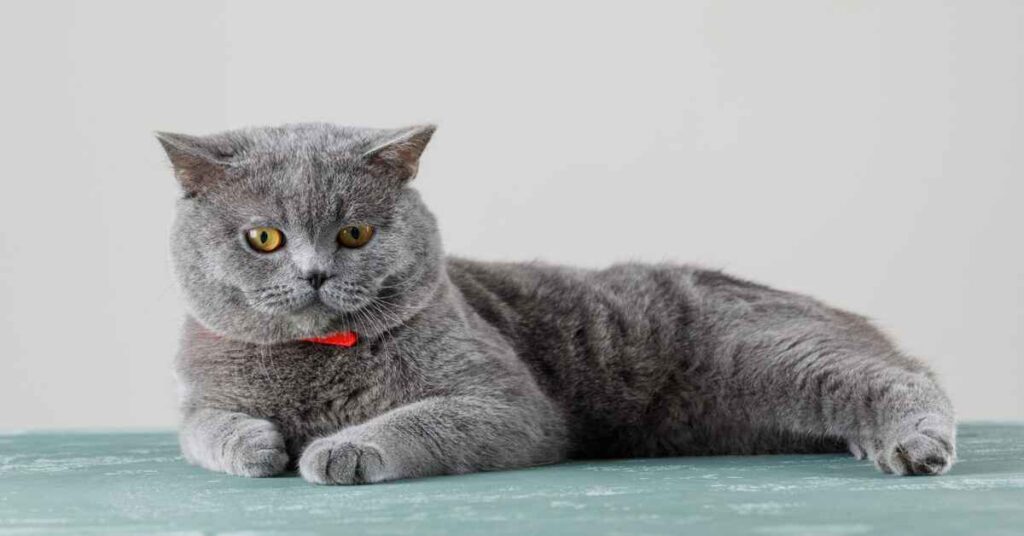
Blue Persian Cat History
The history of the Blue Persian Cat is intertwined with the broader history of the Persian cat breed. The Persian cat’s origins can be traced back to Persia (modern-day Iran).
- The Blue Persian Cat originated in Persia (modern-day Iran) in the 1600s.
- Its striking blue coat comes from a dilution gene affecting the color.
- The breed gained popularity in Europe during the 17th century.
- Persian cats, including the Blue variety, were showcased in early cat shows.
- They officially entered the United States in the late 1800s.
- Blue Persians are known for their regal appearance and calm demeanor.
- The breed continues to be cherished for its beauty and gentle nature today.
Personality and treatments
Personality:
Blue Persian Cats exhibit a unique combination of elegance and tranquility. Their calm demeanor makes them well-suited for indoor living, where they can create a serene ambiance. Despite being laid-back, they often enjoy interactive play and appreciate the company of their human companions. Blue Persians are known for their loyalty, forming strong connections with those around them. Their gentle nature makes them suitable for families or individuals seeking a loving and undemanding feline companion.
Treatments:
In terms of grooming, the Blue Persian Cat’s coat requires special attention. Regular brushing, preferably daily, helps prevent tangles and mats in their long fur. Bathing may be necessary occasionally to maintain their coat’s cleanliness. Eye cleaning might be required due to their facial structure, and regular dental care is essential for their overall health. Routine veterinary visits ensure early detection of any potential health issues, contributing to a long and happy life for the Blue Persian Cat. Providing a consistent and enriched environment, including interactive toys and cozy spaces, caters to their need for mental stimulation and physical comfort.
Blue Persian Cat diet
The dietary needs of a Blue Persian Cat crucially contribute to maintaining their health and well-being. Like all cats, Blue Persians need a balanced diet, including high-quality cat food tailored to their age, weight, and any health considerations.
Because of their brachycephalic facial structure, Blue Persians may struggle to pick up food with their tongues. Therefore, it’s vital to choose kibble that is easy for them to eat. Including wet food in their diet is also beneficial for ensuring proper hydration.
To prevent dehydration, particularly considering their long fur, it’s imperative to provide fresh water at all times. Regularly monitoring their weight and adjusting their food intake accordingly helps prevent obesity, a common concern in Persian cats.
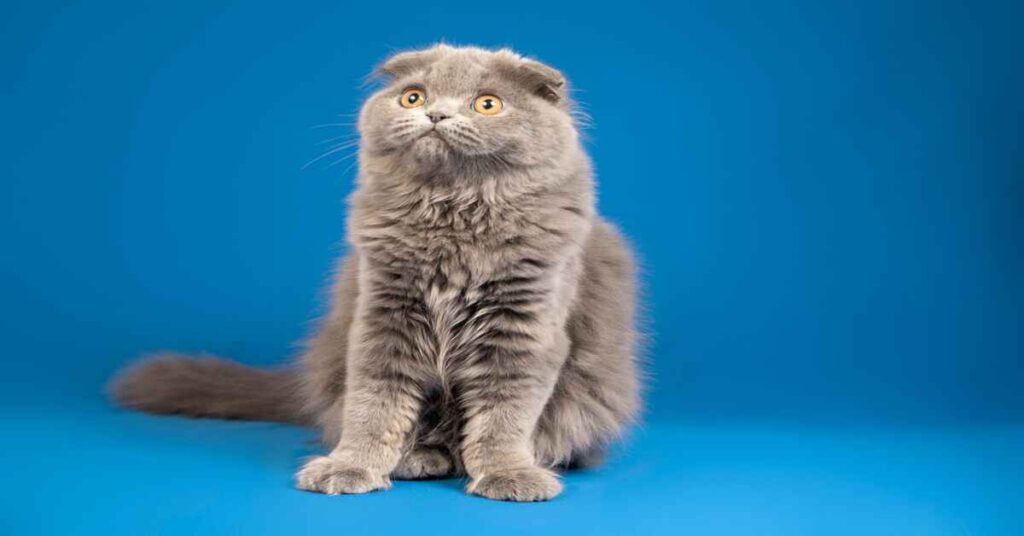
Blue Persian Cat FaQs
Do blue Persian cats shed?
Yes, Blue Persian Cats, like other Persian cats, are known to shed. Their long and luxurious fur requires regular grooming to minimize shedding and prevent matting. Daily brushing is often recommended to remove loose hair and prevent tangles. Shedding can vary among individual cats, and factors such as age, health, and environmental conditions can influence the amount of shedding. Providing proper grooming care helps manage shedding and keeps the Blue Persian’s coat in good condition
What is the lifespan of a Persian blue cat?
The lifespan of a Blue Persian Cat, like other Persian cats, typically ranges from 12 to 16 years, and some may live even longer with proper care. The lifespan can be influenced by factors such as genetics, overall health, diet, and living conditions. Providing regular veterinary check-ups, a balanced diet, and attentive grooming can contribute to the longevity and well-being of a Blue Persian Cat.
How big is a blue Persian cat?
Persian Blue Cats, like other Persian cats, are generally medium to large. Adult males typically weigh between 12 to 16 pounds (5.4 to 7.3 kilograms), while adult females usually range from 7 to 12 pounds (3.2 to 5.4 kilograms). Their body structure is robust, with a sturdy frame and a short, bushy tail. The Persian breed, including the Blue variety, is known for its substantial build, round face, and distinctive features, contributing to its regal and charming appearance.
What does a blue Persian cat look like?
Persian Blue cats have a distinctive appearance with a long, dense, and silky blue coat, ranging from light grayish-blue to deep slate blue. They possess a brachycephalic or flat-faced head structure, large expressive eyes, and small, rounded ears. The body is medium to large, with a sturdy build and a short, bushy tail. Overall, Persian Blue cats are known for their regal and elegant look, characterized by their unique coat color and specific breed features.
Can a blue Persian cat be left alone?
Persian cats generally prefer not to be left alone for extended periods. Leaving a Persian cat alone for too long may lead to boredom or anxiety because they are social animals. To ensure their well-being, it’s advisable to provide ample stimulation, such as toys or climbing structures, and create a comfortable and secure environment. Regular interaction and playtime are crucial for maintaining their mental and emotional health. If you need to leave your Persian cat alone, make sure they have access to food, water, and a litter box. Consider their individual temperament and needs when determining the duration they can be left alone.
What does a blue Persian cat like to eat?
Persian cats prefer high-quality cat food that meets their nutritional needs based on age, weight, and health. Choose a premium cat food brand, whether wet or dry and establish a consistent feeding schedule to maintain their weight and digestive health. Ensure fresh water is always available. It’s essential to avoid feeding them human food, as some items can be toxic. If your Persian cat has specific health concerns or dietary restrictions, consult with a veterinarian to tailor their diet accordingly. Monitoring their weight helps ensure they remain in a healthy condition. Experimentation may be needed to find the specific food that your Persian cat both enjoys and benefits from the most.
Is blue Persian cat hypoallergenic?
Blue Persian Cats, like their Persian counterparts, are not considered hypoallergenic. Hypoallergenic breeds are those that produce fewer allergens, such as dander, which can trigger allergic reactions in some people. Unfortunately, Persian cats, including those with blue coats, have long and dense fur that can trap dander, making them more likely to provoke allergies.
While individual reactions to cat allergens can vary, those with allergies may experience symptoms like sneezing, itching, or respiratory issues around Blue Persian Cats. If someone with allergies is considering a cat as a pet, spending time with the specific breed beforehand can help assess potential allergic reactions. Additionally, regular grooming practices and maintaining a clean living environment can help minimize the presence of allergens in the home.


